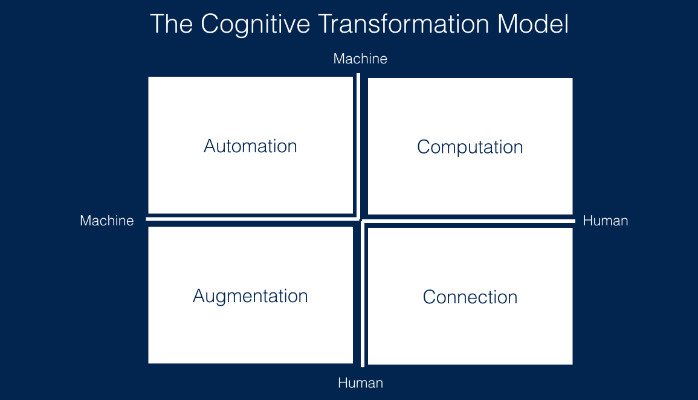To err on the side of progress.
In my previous post, A New Approach for Business Strategy, on the Second Half of the Chessboard, I discussed how the inexorable march of Moore's Law, and the computational power it makes available to us, is rapidly and irrevocably transforming the world around us, through the systems and networks it privileges.
In this post, I will further explore the Cognitive Transformation Model that I introduced with that post. (You can see the original slides over on slideshare here.)
The hypothesis underlying this model is that there are three basic cognitive "asks" from end-users - people - that machines can respond to and serve: they are:
Computation (you command a machine to do something),
Connection (a machine connects you to other users or machines), and
Augmentation (a machine partners you in your actions).
There is a fourth, which functions behind-the-scenes and users see the end-output without necessarily directly engaging with technology - and this is:
pure Automation (machines talking to other machines to keep things running: for now to self-optimize, and in the future to self-organize.)
The purpose of the Cognitive Transformation Model is to give firms an overview and understanding of how their industry is being transformed today, and where their investments need to be.
The areas I spend the majority of my time consulting clients today are in the areas of Performance Marketing (to win the "now") and Digital Transformation (to win the "later").
But it is important to go beyond the disciplines, to the fundamental areas they come from in order to understand why they're important.
My core training lies at the intersection of engineering and anthropology.
Engineering is important to explore possibility and feasibility, and to build the thing: but without anthropology, without user understanding, what we build will not work.
The Cognitive Transformation Model tries to peg the technological change back to the user behavior: which should be the foundation of business decision-making.
Success without establishing this understanding of user behavior in the context of the technologies (and through continuous testing and validation of hypotheses) is as likely to be a false positive as it is to be success.
Which is not the best data set to build your next business assumptions on.
Performance Marketing is about winning the now: about ensuring we are able to keep our clients ahead of the game today, by driving customer acquisition, retention, and growth, through the technologies we have at hand, while keeping an eye on the always-evolving technology stack for new accelerators. I will refrain from elaborating further on user understanding for this workflow, as that is, perhaps, the subject for another post.
Digital transformation is about winning the later. It is not simply about digitization: of moving real-world interactions and transactions online.
It is as much behavioral as it is technological. How do users interact with the emerging technologies and user interfaces? How do they interact with the various data flows (pushed-to or pulled-by them) on this new medium? And, therefore, how do they respond to your incremental presence on their devices and networks?
It is a fine line to walk when structuring your investments and defining your strategic priorities. What is evident between that core tension: of digitization versus digital transformation, is that what is your core business today will have to evolve in dramatic ways in order to be competitive in that new world (with new user behaviors) created by the exponential nature of the technologies available to them today.
To explore the impact of such changes, check out this fantastic podcast by Benedict Evans and Steve Sinofsky of Andreeson Horowitz, where they explore the S-Curves in personal computing over the past ~30 years, and how each curve gives new firms the opportunity to win.
Whether it's the evolution of the Intel x86-based personal computing world, or the ARM-based mobile computing world; the shifts in architectures and screens, and the dramatic shifts in user behavior that follow leave all leaders vulnerable. The other important thing to note is that the winners aren't the first-to-market, they are the first-to-scale, along a dominant behavior.
Even as Sinofsky and Evans discuss mobile, I believe we are already moving into the next discussion, and the next phase of computing: of Voice as the key User Interface across a distributed set of devices at home and at work. Whether it's Siri or Alexa, or Watson, Cortana, or Google Assistant.
This is where the Cognitive Transformation Model comes into play.
It is a simplified framework to impose upon, and understand the fundamental interactions your existing model privileges, and shows you how each quadrant pivots into the other.
There are deeper behavioral models that the Cognitive Transformation Model is built upon, based on the theories of Innis, McLuhan and Baudrillard, and real world application (and validation) at scale.
By understanding where you are in the model, you can map out the inflection point where your existing model will go from growth to sustain: and where you need to invest in terms of digital transformation, in order to drive alpha.
You can, for example, layer it with the BCG Growth Share Matrix to understand the market size, potential, and growth rate, vs. your portfolio's size, potential, and growth rate across each quadrant.
It is a useful guide to reduce the possibility of strategic errors. But remember, even then, that the strategy is only half the battle: disciplined execution is equally important.
What you ultimately need to keep in mind from this post are three things:
Digitization is not digital transformation. Look for the emerging user behavior in the new model in order to understand what might work, and therefore where you need to invest.
Performance marketing and other technological optimizations will keep you in the game for now: but the business model that works for you today is not the business model that will work for you tomorrow: you need to build a two-speed organization to tackle this dichotomy.
When you place your firm on the Cognitive Transformation Model, the solution to your business challenge will lie not in the quadrant you are in, but one of the other two areas you could pivot into.
In the exponential times in which we live today, there is no middle ground.
Today, you must err on the side of progress.
Start with the user, and go beyond where your business lies today, to build your business' tomorrow.
As Beth Comstock of GE shared recently, "If at first the idea is not absurd, then there is no hope for it." - Albert Einstein.
To close, we don't make mistakes: we make the future.
Allez. Bon courage.


